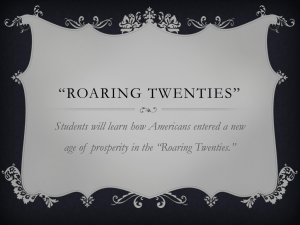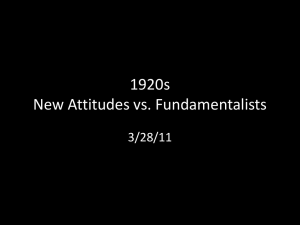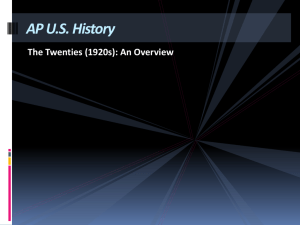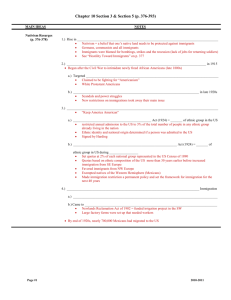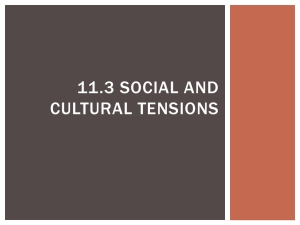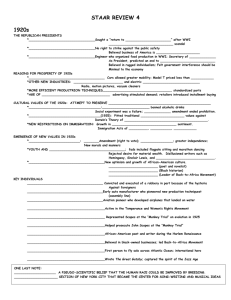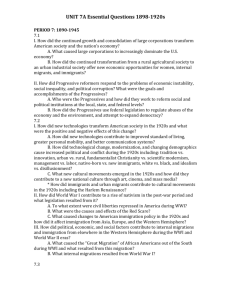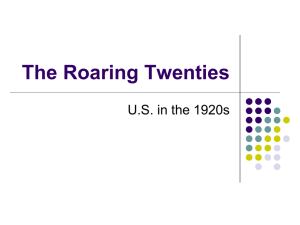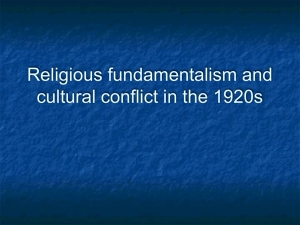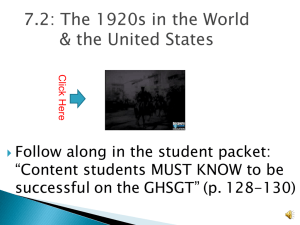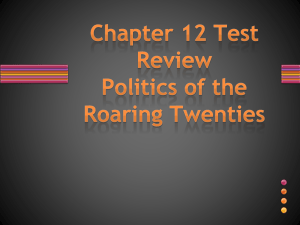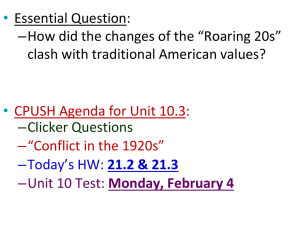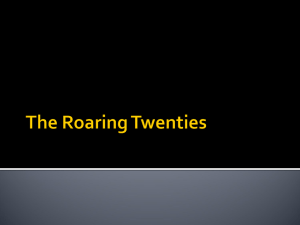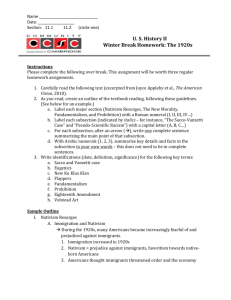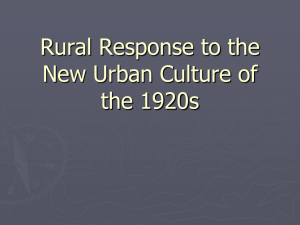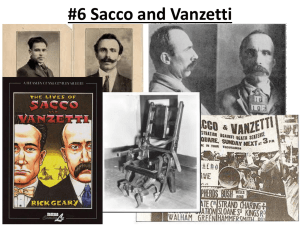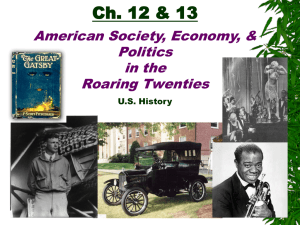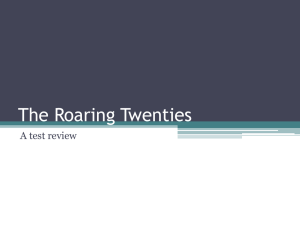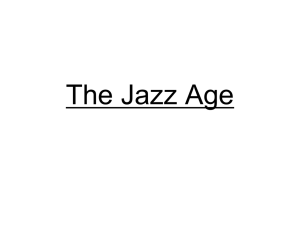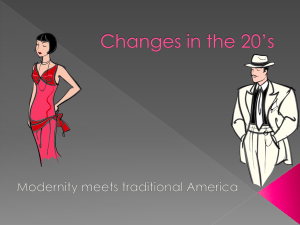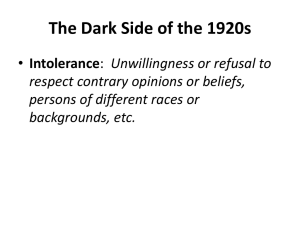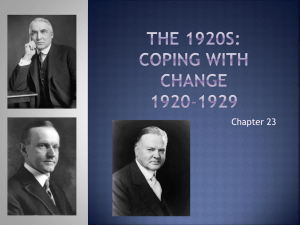AMH Chapter 10 Section 3
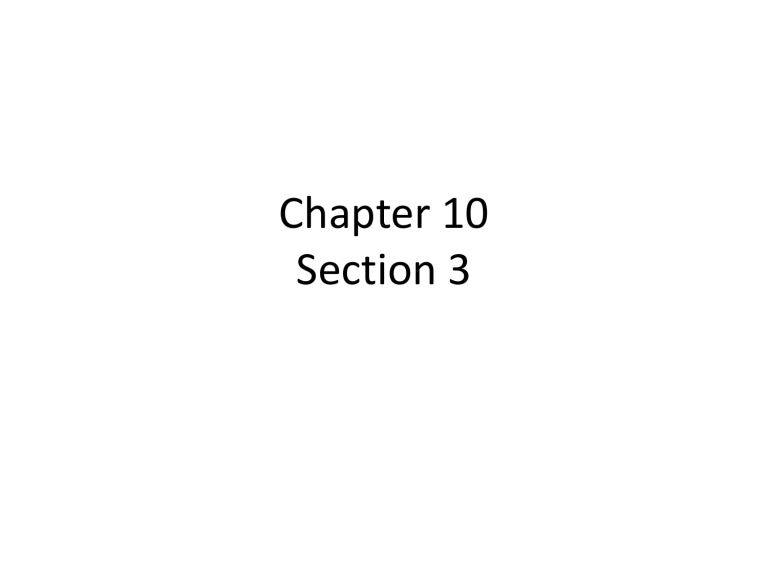
Chapter 10
Section 3
Disillusionment & Intolerance
• In the early 1920s, an economic recession, an influx of immigrants, and cultural tensions created an atmosphere of disillusionment
(disappointment) and intolerance (prejudice).
• Nativism, the belief that one’s native land needs to be protected against immigrants, also grew.
Sacco & Vanzetti
• In 1920 two Italian immigrants named Nicola Sacco and
Bortolomeo Vanzetti were arrested for armed robbery and murder.
• It was widely reported that they were anarchists, people who oppose all forms of government.
• Despite thin evidence, Sacco and Vanzetti were found guilty and later executed.
• The Sacco and Vanzetti case reflected fear and prejudice against immigrants.
1920s and KKK
• One of the biggest efforts to restrict immigration came from the Ku Klux
Klan.
• It targeted groups it felt did not represent traditional American values.
• The Ku Klux Klan claimed it was fighting for
Americanism and had nearly four million members by 1924.
Restricting Immigration
• In 1921 Congress passed the
Emergency Quota Act to limit immigration.
– According to the Emergency
Quota Act, only three per cent of the total number of people in any ethnic group already living in the United States could be admitted in a single year.
• The National Origins Act of
1924 made the quotas stricter and permanent.
– The National Origins Act of
1924 deliberately used data from the 1890 Census to favor immigrant groups from northwestern Europe.
Mexican Immigrants
• The reduction in immigration caused a shortage of workers for agriculture, mining, and railroad work; Mexican immigrants filled these jobs.
• Large numbers arrived after the Newlands
Reclamation Act of 1902 funded projects in the
Southwest.
New Morality
• During the 1920s, a “new morality” took over the nation.
• The new morality challenged traditional ways of thinking.
• Many groups that wanted to restrict immigration also feared the “new morality” that glorified youth and personal freedom which changed
American Society.
Changing Roles
• In 1920, women won the right to vote.
• Many women in the
1920s wanted to break free from traditional roles and expected behaviors.
• Thus, attitudes toward marriage changed.
– The ideas of romance, pleasure, and friendship became linked to successful marriages.
Women of the 1920s
• Single women began working for their own financial independence as employment opportunities increased during the 1920s.
• Women’s colleges encouraged students to pursue careers.
• Many professional women made contributions in fields such as science, medicine, law, and literature.
• A flapper was a woman who personified the fashion and social changes of the 1920s.
Fundamentalists
• Many Americans embraced the new morality, while others feared the loss of traditional values.
• Evangelist Aimee Semple
McPherson conducted revivals and faith healings in a flamboyant theatrical style.
• A religious movement called
Fundamentalism stressed the teachings of the Bible as literally true history.
• Fundamentalists rejected the theory of evolution, which argued that human beings had developed from lower forms of life over the course of millions of years.
Scope Trial
• Fundamentalists believed in
creationism, which says that God created the world as described in the Bible.
• In 1925 Tennessee outlawed the teaching of evolution.
• A high school biology teacher named John T. Scopes was tried and convicted of breaking this law.
• The Scopes Trial was about the teaching of evolution in schools, which helped illustrate the struggle between the new morality and traditional beliefs.
18
th
Amendment
• In January of 1920 the
Eighteenth Amendment went into effect.
• The Eighteenth Amendment specifically granted federal and state governments the power to enforce Prohibition.
• This amendment prohibited, or banned, the sale of alcohol.
• Many people felt prohibition would reduce unemployment, violence, and poverty.
Organized Crime
• Congress passed the Volstead
Act to enforce the law, but many Americans violated it.
• As the Treasury Department struggled to enforce
Prohibition, organized crime thrived on the illegal trade in alcohol.
• Organized crime supplied illegal alcohol to secret bars called speakeasies.
• Prohibition ended in 1933 with the ratification of the Twentyfirst Amendment.
